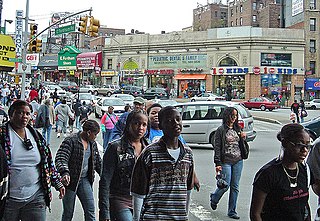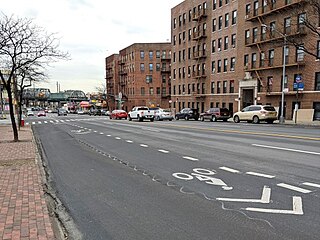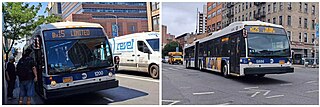
The 5 Lexington Avenue Express is a rapid transit service in the A Division of the New York City Subway. Its route emblem, or "bullet", is colored forest green since it uses the IRT Lexington Avenue Line in Manhattan.

The Interborough Rapid Transit Company (IRT) was the private operator of New York City's original underground subway line that opened in 1904, as well as earlier elevated railways and additional rapid transit lines in New York City. The IRT was purchased by the city on June 12, 1940, along with the younger BMT and IND systems, to form the modern New York City Subway. The former IRT lines are now the A Division or IRT Division of the Subway.

The Parkchester station is an express station on the IRT Pelham Line of the New York City Subway. It is located above Hugh J. Grant Circle in the Parkchester neighborhood of the Bronx, where East 177th Street, Metropolitan Avenue, and Westchester Avenue intersect. The station is served by the 6 train at all times and the <6> train during weekdays in the peak direction.

The 138th Street–Grand Concourse station, also signed as 138th Street–Mott Haven or simply as Mott Haven on station signage, is a local station on the IRT Jerome Avenue Line of the New York City Subway, located at the T-intersection of East 138th Street and the Grand Concourse in the Mott Haven neighborhood of the Bronx. It is served by the 4 train at all times except during rush hours in the peak direction, and the 5 train at all times except late nights.

Melrose is a mostly residential neighborhood in the southwestern section of the New York City borough of the Bronx. It adjoins the business and one-time theater area known as The Hub. Melrose is rectangular-shaped, being bordered by Saint Anns Avenue on the east, 149th Street on the south, Park Avenue on the west, and 163rd Street to the north. Melrose Avenue and Third Avenue are the primary thoroughfares through Melrose.

Mott Haven is a primarily residential neighborhood in the southwestern section of the New York City borough of the Bronx. It is generally bounded by East 149th Street to the north, the Bruckner Expressway to the east and south, and the Harlem River to the west, although these boundaries are not precise. East 138th Street is the primary east–west thoroughfare through Mott Haven.

The Third Avenue–138th Street station is an express station on the IRT Pelham Line of the New York City Subway located at the intersection of Third Avenue and East 138th Street in the Mott Haven neighborhood of the Bronx. It is served by the 6 train at all times and the <6> train during weekdays in the peak direction.

The IRT Third Avenue Line, commonly known as the Third Avenue Elevated, Third Avenue El, or Bronx El, was an elevated railway in Manhattan and the Bronx, New York City. Originally operated by the New York Elevated Railway, an independent railway company, it was acquired by the Interborough Rapid Transit Company (IRT) and eventually became part of the New York City Subway system.
The IRT Pelham Line is a rapid transit line on the New York City Subway, operated as part of the A Division and served by the 6 and <6> trains. It was built as part of the Dual Contracts expansion and opened between 1918 and 1920. It is both elevated and underground with Whitlock Avenue being the southernmost elevated station. It has three tracks from the beginning to just south of the Pelham Bay Park terminal. The Pelham Line also has a connection to Westchester Yard, where 6 trains are stored, just north of Westchester Square–East Tremont Avenue.

Fordham Road is a major thoroughfare in the Bronx, New York City, that runs west-east from the Harlem River to Bronx Park. Fordham Road houses the borough's largest and most diverse shopping district. It geographically separates the geopolitical North Bronx from the South Bronx.

The Bx41 is a public transit line in New York City. It runs within the borough of the Bronx, operating along Melrose and Webster Avenue.

The Bx1 and Bx2 are two bus routes that run on the Grand Concourse in the Bronx, New York City. The routes, which are operated by the Manhattan and Bronx Surface Transit Operating Authority, also follow Sedgwick Avenue and Mosholu Parkway for a short distance at their northern end. As the numbers suggest, these were the first two bus routes in the Bronx.

The Hub is a major commercial center for the South Bronx, New York. It is located where four roads converge: East 149th Street, Willis Avenue, Melrose Avenue, and Third Avenues. It is primarily located inside the neighborhood of Melrose but also lines the northern border of Mott Haven.
The 129th Street station was a transfer station on the IRT Third Avenue Line in Manhattan, New York City, shared by elevated trains of both the Third Avenue Line and IRT Second Avenue Line. The next stop to the north was 133rd Street for the main line and Willis Avenue for the Willis Avenue spur, both of which were across a swing bridge above the Harlem River in the Bronx. The next stop to the south was 125th Street−Third Avenue for Third Avenue Line trains and 125th Street−Second Avenue for Second Avenue Line trains.

The 149th Street station was a station on the demolished IRT Third Avenue Line in the Bronx, New York City. It was located in "The Hub" in the South Bronx, at the intersection of 149th Street, Third Avenue, Willis Avenue, and Melrose Avenue. Opened as an express station in 1887 and later operating as the line's southern terminus, the station closed in 1973 and was demolished by 1977 due to political pressure in the area.

Southern Boulevard is a street in the Bronx, New York City, United States. It stretches from Bruckner Boulevard in Mott Haven to Bronx Park East in Bronx Park where it becomes Allerton Avenue.

Westchester Avenue is a major east–west street in the South and East portions of the Bronx, New York City. It runs from Third Avenue and East 150th Street in the Hub to Pelham Bay Park in the Pelham Bay section. It crosses many neighborhoods of the Bronx, which include Melrose, Longwood, Soundview, Parkchester, and Pelham Bay. Westchester Avenue parallels the Bruckner Expressway until their junction at Pelham Bay Park.

The Bx15 and M125 bus routes constitute the Third Avenue/125th Street Line, a public transit line in New York City. The Bx15 runs between Fordham Plaza and the Hub in the Bronx, running primarily along Third Avenue. The M125 runs between the Hub in the Bronx and Manhattanville in Manhattan, running along Willis Avenue in the South Bronx and along 125th Street in Harlem, Manhattan.

The 138th Street station was a station on the Harlem and Hudson Lines of the New York Central Railroad, serving the community of Mott Haven in the Bronx, New York City. It was the southernmost station along both branches until 1973. The New York, New Haven and Hartford Railroad also ran through this station but did not stop here.




















